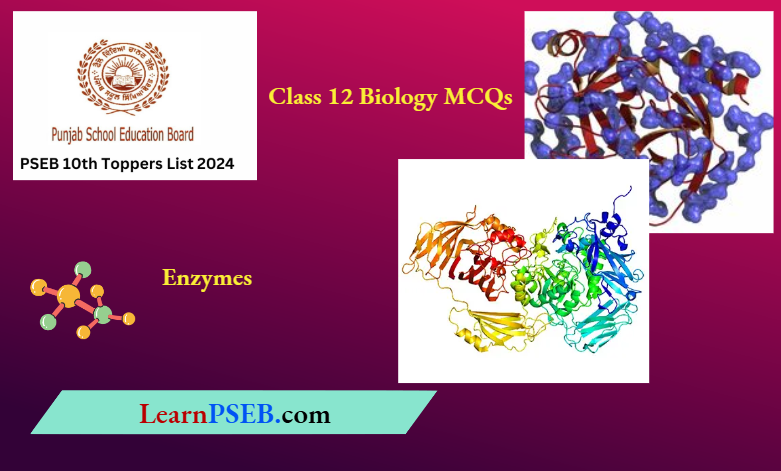Enzymes Multiple Choice Questions
Question 1. The enzyme which joins with the non-proteinic part to form a functional enzyme is:
- Holoenzyme
- Prosthetic group
- Apoenzyme
- Coenzyme.
Answer: 3. Apoenzyme
Question 2. Enzymes that help in electron transfer are :
- Cytochrome
- Isomerase
- Proteinase
- All of the above.
Answer: 1. Cytochrome
Question 3. Induced-fit theory of enzyme action was given by:
- Koshland
- Sumner
- Fischer
- Hershey and Chase.
Answer: 1. Koshland
Read and Learn More 12th Class Biology MCQs
Question 4. The most abundant enzyme among living organisms is:
- Catalase
- Rubisco
- Nitrogenase
- Invertase.
Answer: 2. Rubisco
PSEB 12th Class Biology Enzymes MCQs

Question 5. Enzymes speed up the rate of reaction by :
- Combining with product
- Forming reactant-product complex
- Changing the equilibrium of the reaction
- Lowering activation energy.
Answer: 4. Lowering activation energy.
Question 6. The enzyme which fixes CO2 in C4 plants, is :
- Hydrogenase
- Pepcarboxyease
- Reductase
- Rubp carboxylase.
Answer: 2. Pepcarboxyease
Question 7. Endoenzymes generally act at:
- Neutral ph
- Alkaline ph
- Any ph
- Acidic ph.
Answer: 1. Neutral ph
Question 8. The nomenclature of the enzyme consists of :
- First name of the product and then reaction name
- Only product name
- Only reaction name
- First reaction, then product name.
Answer: 1. First name of the product and then reaction name
Question 9. Holoenzyme is :
- Protein moiety of enzyme
- Non-protein moiety of enzyme
- Complete enzyme
- Inactive enzyme.
Answer: 3. Complete enzyme
Enzymes Multiple Choice Questions PSEB Class 12
Question 10. The energy released from enzyme-substrate interaction is known as:
- Activation energy
- Binding energy
- Constant energy
- Variable energy.
Answer: 2. Binding energy
Question 11. The enzyme involved in the hydrolysis of starch to maltose is called:
- Sucrase
- Amylase
- Lactase
- Maltase.
Answer: 2. Amylase
Question 12. The hydrolytic enzymes acting at low pH are termed:
- Alpha amylase
- Hydrolases
- Proteases
- Pyrimnidases
Answer: 1. Alpha-amylase
Question 13. The glycogen in a dead or killed animal is disintegrated by the enzymatic action to:
- Glucose
- Fructose
- Lactose
- None of the above.
Answer: 4. None of the above.
Question 15. Enzymes, vitamins, and hormones can be classified into a single category of biological chemicals because all of these:
- Enhance oxidative metabolism
- Ale conjugated proteins
- Are exclusively synthesized in the body of a living
an organism as at present. - Help in regulating metabolism
Answer: 4. Help in regulating metabolism
Question 16. Which of the following statements regarding enzyme inhibition is correct?
- Non-competitive inhibition of an enzyme can be overcome by adding a large amount of substrate.
- Competitive inhibition is seen when a substrate competes with an enzyme for binding to an inhibitor protein.
- Competitive inhibition is seen when the substrate and the inhibitor compete for the active site on the
- Non-competitive inhibitors often bind to the enzyme irreversibly.
Answer: 3. Competitive inhibition is seen when the substrate and the inhibitor compete for the active site on the
Class 12 Biology Chapter Enzymes MCQs
Question 17. The catalytic efficiency of two different enzymes can be compared by the :
- The km value
- The pH optimum value
- Formation of the product
- The molecular size of the enzyme.
Answer: 1. The km value
Question 18. Telomerase is an enzyme that is a :
- Repetitive dna
- Rna
- Simple protein
- Ribonucleic protein
Answer: 4. Ribonucleoprotein
Question 19. The figure given below shows three velocity-substrate concentration curves for an enzyme reaction. What do the curves a, b, and c depict respectively?
Image-
- A-normal enzyme reaction, b-competitive c-non-competitive inhibition
- A-enzyme with an allosteric modulator added, b-normal enzyme activity, c-competitive inhibition
- A-enzyme with an allosteric stimulator, b-competitive inhibition added c-normal enzyme reaction
- A-normal enzyme reaction. B-non-competitive inhibitor added
c-allosteric inhibitor added.
Answer: 1. A-normal enzyme reaction, b-competitive c-non-competitive inhibition.
Question 21. In which one of the following sets of three items each belong to the category tensioned against them?
- Lysine, glycine, thiamine…..amino acids
- Myosin, oxytocin, and gastrin……hormones
- Rennin, helicase, and hyaluronidase….enzymes
- Optic nerve, oculomotor, vagus…..sensory nerves.
Answer: 3. Rennin, helicase, and hyaluronidase….enzymes
Question 21. Assertion: a coenzyme or metal ion that is very tightly bound to an enzyme protein is called a prosthetic.
Reasons: a complete, catalytically active enzyme together with its bound prosthetic group is called an apoenzyme.
- Both and (r) are true and (r) is the correct explanation of the
- Both and (r) are true but the (r) is not the correct explanation of the
- Is a true statement but (r) is false
- Both and (r) are false.
Answer: 3. Is a true statement but (r) is false
Question 22. If by radiation all nitrogenase enzymes are inactivated, then there will be no :
- Fixation of nitrogen in legumes
- Fixation of atmospheric nitrogen
- Conversion from nitrate to nitrite in legumes
- Conversion from ammonium to nitrate in soil.
Answer: 1. A fixation of nitrogen in legumes
Question 23. Which of the following cell organelles is rich in catabolic enzymes?
- Ribosomes
- Chloroplast
- Mitochondria
- Golgi complex.
Answer: 3. Mitochondria
Question 24. Cytochrome oxidase is a.an :
- Coenzyme
- Proenzyme
- Exoenzyme
- Endoenzyme
Answer: 4. Endoenzyme
Question 25. Enzymes found attached to the inner membrane of mitochondria instead of the matrix are :
- Succinic acid dehydrogenase
- Cytochrome oxidase
- Malic acid dehydrogenase
- Both 1 and 2.
Answer: 4. Both 1 and 2.
PSEB 12th Class Biology Enzymes Questions with Answers
Question 26. A competitive inhibitor of succinic dehydrogenase is :
- Malate
- Maionate
- Oxaloacetate
- A-ketoglutarate
Answer: 2. Maionate
Question 27. An example of feedback inhibition is :
- Cyanide action on cytochrome
- Sulpha drug on folic acid synthesizer bacteria
- Allosteric inhibition of hexokinase by glucose 6- phosphate
- Reaction between succinic dehydrogenase and succinate.
- The inhibition of succinic dehydrogenase by malonate.
Answer: 3. Allosteric inhibition of hexokinase by glucose 6- phosphate
Question 28. The essential chemical components of many coenzymes
- Nucleic acids
- Carbohydrates
- Vitamins
- Proteins
Answer: 3. Vitamins
Question 29. The transition state structure of the substrate formed during an enzymatic reaction is :
- Permanent but unstable
- Transient an unstable
- Permanent and stable
- Transient but stable
Answer: 2. Transient an unstable
